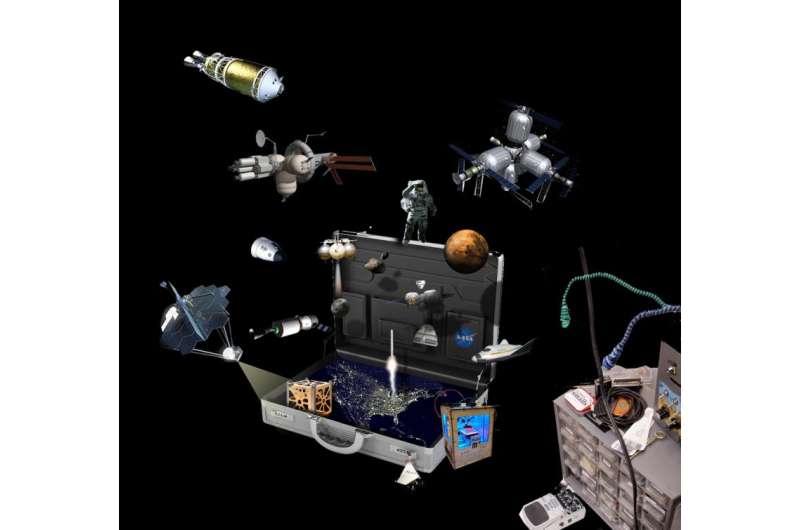NASA selects economic research studies to examine investments in space

NASA has selected five new research proposals to understand the effective drivers of investments in the global space economy, encouraging non-traditional companies, as well as traditional aerospace companies, to look beyond satellites for new opportunities in commercial space development.
"Our space technology work is focused on providing new capabilities for robotic and human exploration of the solar system, but we are also here to help enable new commercial markets or enterprises," said Steve Jurczyk, associate administrator for the Space Technology Mission Directorate at NASA. "The results of these studies provide insights into the potential economic impacts of new space-based capabilities and applications which in turn helps guide our investments in technology development."
The five studies selected this year will cover topics ranging from in-space manufacturing in low-Earth orbit (LEO) to the economics of resources obtained from the Moon to support a wide range of government and commercial enterprises.
- Vision Foresight Strategy LLC (Honolulu) offers a comprehensive report on the risks, vulnerabilities, and consequences of severe space weather events as well as an assessment model for forecasting future vulnerabilities and damage estimates in their proposal: "A Rigorous Foresight Approach to Understanding and Modeling the Societal and Economic Impacts of Severe Space Weather." The proposed project offers to provide a better understanding of the societal and economic impacts of space weather at the global and country level and over time.
- The Massachusetts Institute of Technology's (Cambridge, Massachusetts) proposal "Development of a Commercial Space Technology Roadmap," offers a companion to existing NASA space technology roadmaps by focusing on technology development efforts and needs from the perspective of commercial economic development. The identification of key technology gaps and their relationship to proposed enterprises and economic development as well as to other NASA objectives, such as exploration and scientific investigation, will help inform NASA where the agency can facilitate technology development for the benefit of commercial enterprises, as well as identify areas where commercial and government interests are well-aligned.
- Planetary Resource Engineering LLC (Canterbury, New Hampshire) will focus on the quantitative evaluation of scenarios to estimate the effect of both supply and demand side stimulation through public-private partnerships. A robust, private sector, commercial lunar ecosystem could provision propellant, life support consumables and other materials to NASA as one among many customers. "Public-Private Partnerships Framework for Multi-Commodity Lunar In-Situ Resource Utilization" will draw upon comparisons to terrestrial mining activities, where byproducts often generate more operating profit than a primary commodity produced. A secondary objective of the proposed work will examine lunar resource byproduct scenarios that may deliver high economic benefits for relatively low incremental costs.
- The Colorado School of Mines (Golden, Colorado) proposal focuses on "21st Century Trends in Space-Based Solar Power Generation and Storage." This study will determine the feasibility of using space-based solar power to meet near-term commercial energy demands for mining and resource extraction in space and on Earth. The ability to mine materials in space could be instrumental in the development of a thriving space economy. Resources from asteroids, the Moon, and other planetary bodies in space can support NASA's long-term goals for human space exploration and science discovery by offering consumables for human space flight enterprises, propellants and refueling opportunities, and energy for a variety of uses. The private sector and commercial enterprises are likely to be major partners in this endeavor.
- The University of Illinois, Urbana (Urbana, Illinois) offers "An Integrated Framework and Tool for Effective Participation of Commercial Enterprise in Space Development." This proposal develops a mixture of quantitative and qualitative methods to identify the space development architectures that are beneficial and commercial-friendly, and analyze their synergistic effects with other government incentives. Selecting the proper architecture is the most important decision in ensuring effective and sustainable space exploration and development. The results from this work will offer guidance to create an environment that attracts beneficial and effective contributions from commercial players and investors.
"The 23 proposals submitted to this year's NASA Research Announcement reflect the interest of an increasingly sophisticated and capable entrepreneurial space community that recognizes the diversity of new opportunities beyond Earth for commercial development," said L.K. Kubendran, portfolio executive for the Commercial Partnerships at NASA. "The studies we chose will help us understand the dynamics and potential of future commercial space developments, both in partnership with the government, and as privately funded ventures, as well as the potential economic impacts from space weather events that can affect the global economy."
More information: For more information about the Emerging Space Grants, visit www.nasa.gov/directorates/spacetech/emergingspace
Provided by NASA
















